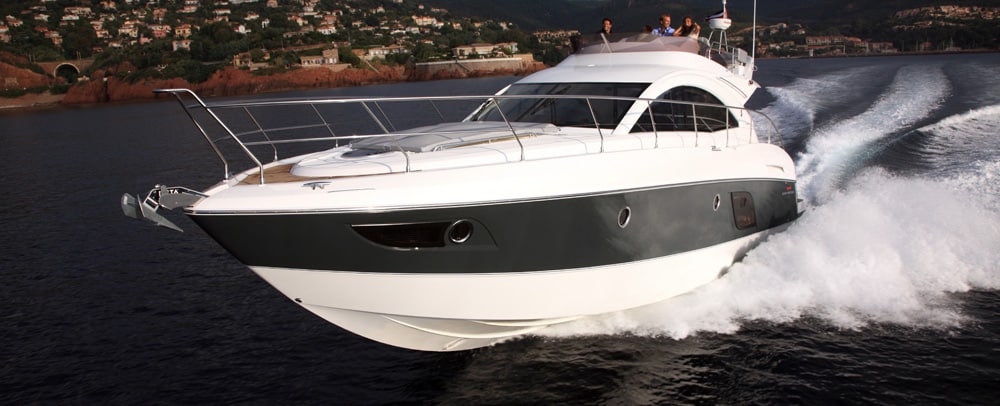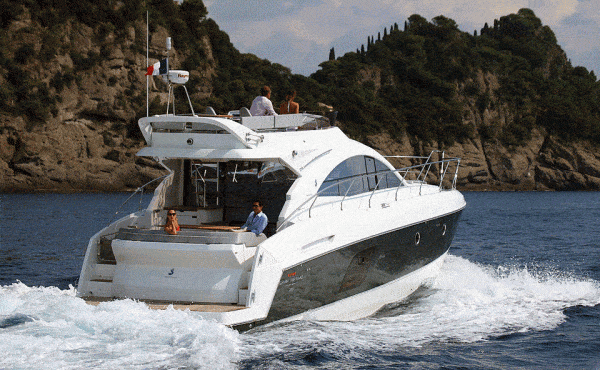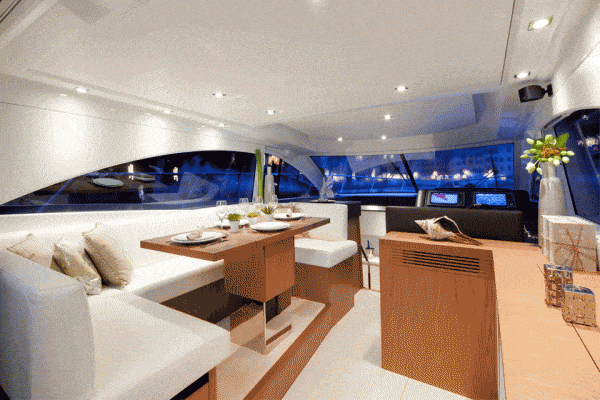
Beneteau Flyer GT 49 Main
Let’s get something out of the way for all you naysayers and dedicated fossil fuel loyalists: Yes, Beneteau, a company with a 125-year history, is known as a builder of sailboats, garnering a loyal and dedicated following due in large part to its unfailing resolve never to cut corners on its construction or service. However, when the company introduced the Swift Trawler 42 in 2004, it opened the floodgates. The Barracuda, Antares and Monte Carlo lines followed, and now the Flyer Gran Turismo series in lengths of 34, 38, 44 and 49 feet in express and flying-bridge models shows that the company is very serious about what it can offer in this highly competitive market segment.
“You can especially see how important the commitment the company has undertaken is, with the significant amount of R&D money Beneteau has put into the launch of the GT series,” said Alex Wilkes, part of the Denison Yacht Sales group.
A boat’s cockpit is its welcome mat, and the one aboard the GT 49 seemed adequately large, its table and transom seating leaving plenty of room to move around. An optional helm station is available here, as well as an outdoor grill. The hydraulically operated swim platform helps in launching the 11-foot tender from its garage under the cockpit. I inspected the engine room via the cockpit hatch before going into the accommodations and noted the ease of checking fluids prior to casting off.

A few minutes later, we left the dock and began idling along the upper reaches of Fort Lauderdale’s serpentine, and often quite narrow, New River.
The normally busy waterway was already in the throes of a rip-roaring incoming tide. Steering at the lower station without having to do any throttle jockeying, courtesy of the fast reaction of the twin 435 hp Volvo Penta D6 IPS600s, made navigating the quickly changing nautical pinball game just a bit more relaxed. The lower station’s big forward windows and those to either side provided me with excellent sight lines, adding to the feeling of control that comes with pod drives.
By the time we had motored downriver to where the waterway opened, I noticed that the wind was blowing at a constant 30 knots. When we arrived at the channel markers indicating the Port Everglades Inlet and poked the GT 49’s bow seaward, we got a peek at the horror show going on out in the ocean.
After a very brief discussion, we agreed to confine my testing to the Intracoastal Waterway. We headed south toward Dania, where we had enough running room outside of the no-wake zones to get accurate performance numbers.
Although the flying bridge is roomy and offers superior sight lines, I chose to do my evaluations from the salon station. The reason: When putting a boat with dual helms through her paces from the bridge, there is no way to assess what happens to the view of the seaway from the helm during acceleration. On many a vessel coming up out of the hole, while steering from below, the driver can lose the horizon long enough to miss that nasty “wood shark” lying dead ahead or some other nefarious flotsam just waiting to strike the hull or do damage to the propulsion units. This was not an issue with the GT 49. During four runs, all with the boat coming up onto plane accompanied by the normal bow rise, not once did I lose sight of the seaway. And consider that I am 5 feet 9 inches tall, was seated and didn’t have to crane my neck. The overall performance test resulted in an average fast cruise of 27.7 knots burning 42 gph at 3300 rpm, and a slow cruise average of 18.3 knots, with a 26 gph fuel rate at 2700 rpm. And with her responsive handling, the GT 49 is fun to drive. She quickly answers to the helm, executes tight turns and tracks a true course in a straight line.
I also liked the boat’s interior layout. Large windows all around and 6 feet 6 inches of headroom add to the feeling of spaciousness in the salon. The helm is on the starboard side; a sofa and table is opposite, giving occupants a perfect view of the TV abaft the helm. Below, light from the windshield and a view of the sky make the galley and dinette feel like an atrium. The guest stateroom is forward. The pods allow a full-beam master stateroom under the salon. It has an en suite head and a large locker.

The noteworthy fit and finish throughout is complemented by her quality construction details, including a solid fiberglass bottom with coring from the waterline up, low profile exterior styling featuring wide walkways on both sides and high, sturdy rails for safe passages, and the kind of attention to detail one would expect from a company of this pedigree.
View a complete photo gallery here.
Test Conditions: Speeds were measured by GPS in the Intracoastal Waterway in calm seas and 15-knot winds, with a 5/8 load of fuel, no water and three people on board. Fuel consumption was calculated by the electronic engine-monitoring system. Sound levels were measured at the helm.
RPM Knots GPH dB(A)
650 4.4 .7 62
1000 5.8 1.6 63
1200 7.0 2.0 66
1500 8.0 5.5 67
1800 9.7 8.6 71
2100 12.0 16.0 73
2400 14.2 21.0 74
2700 18.3 26.0 75
3300 27.4 42.0 80
3600 28.6 44.0 84
LOA: 51’2″
LWL: 45’11”
BEAM: 14’1″
DRAFT: 3’7″
DISPL.: 27,550 lb.
FUEL: 344 gal.
WATER: 170 gal.
TRANSOM DEADRISE: 16 degrees
TEST POWER: 2 x 435 hp Volvo Penta IPS600 diesels
BASE PRICE: $686,800
PRICE AS TESTED: $858,700
Beneteau USA, 410-990-0270; www.beneteauusa.com









